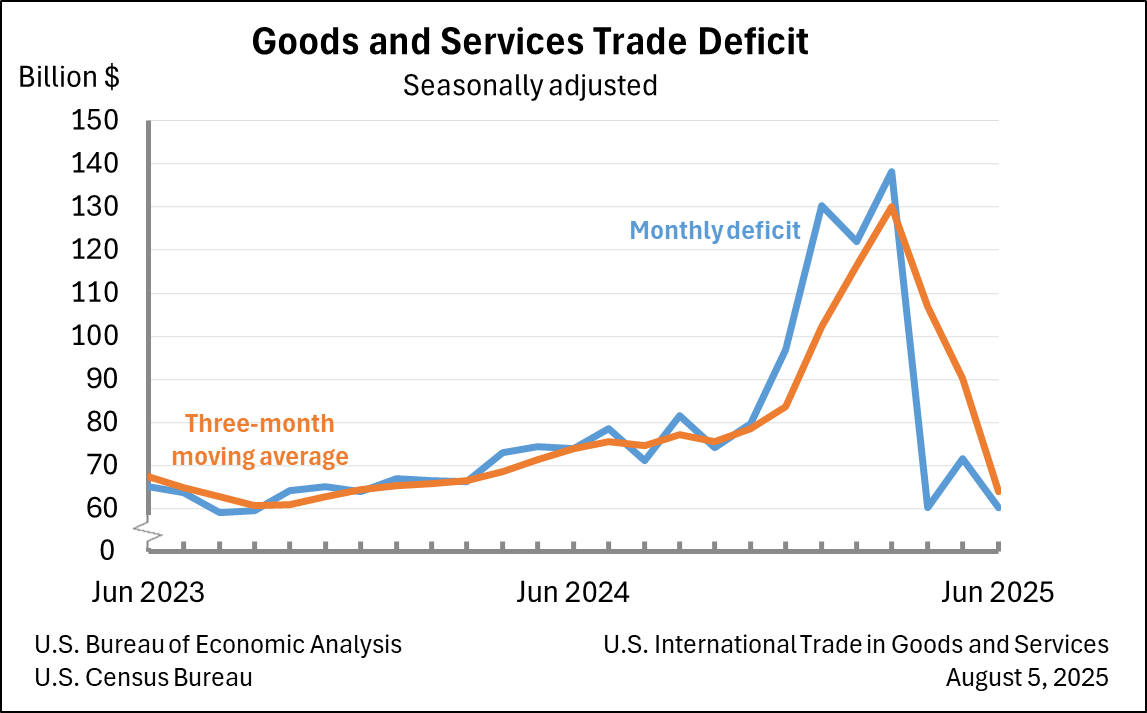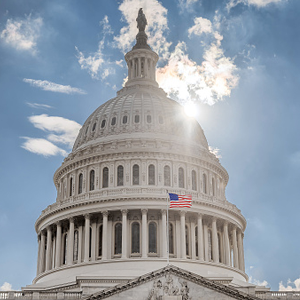Bureau of Economic Analysis
U.S. International Trade in Goods and Services, June 2025
The U.S. goods and services trade deficit decreased in June 2025 according to the U.S. Bureau of Economic Analysis and the U.S. Census Bureau. The deficit decreased from $71.7 billion in May (revised) to $60.2 billion in June, as exports decreased less than imports. The goods deficit decreased $11.4 billion in June to $85.9 billion. The services surplus increased $0.1 billion in June to $25.7 billion.
Principal Federal Economic Indicators
Noteworthy
- 2025 News Release Schedule
- Innovation at BEA
- 2025 Annual Updates
- Distribution of Personal Income Nowcast
- New! Services Trade Data for More Countries
- Data Tool: Trade in Value Added
- Updated: RIMS II Regional Multipliers
- Arts and Culture
- Space Economy
- FDI Now in State BEARFACTS
- Quick Guide: Price Indexes
The Latest
U.S. Net International Investment Position Year 2018
The U.S. net international investment position decreased to −$9,717.1 billion (preliminary) at the end of 2018 from −$7,725.0 billion at the end of 2017. The $1,992.1 billion decrease reflected net financial transactions of −$519.6 billion and net other changes in position, such as price and exchange-rate changes, of −$1,472.6 billion.
U.S. Net International Investment Position, Fourth Quarter and Year 2018
The U.S. net international investment position decreased to -$9,717.1 billion (preliminary) at the end of the fourth quarter of 2018 from -$9,634.8 billion (revised) at the end of the third quarter, according to statistics released by the Bureau of Economic Analysis (BEA).
Personal Income Increases in February
Personal income increased 0.2 percent in February after decreasing 0.1 percent in January. Wages and salaries, the largest component of personal income, increased 0.3 percent in February, the same increase as in January.
Personal Income, February 2019; Personal Outlays, January 2019
Personal income increased 0.2 percent in February after decreasing 0.1 percent in January. Wages and salaries, the largest component of personal income, increased 0.3 percent in February, the same increase as in January.
GDP Increases in Fourth Quarter
Real gross domestic product (GDP) increased 2.2 percent in the fourth quarter of 2018, according to the “third” estimate released by the Bureau of Economic Analysis. The growth rate was revised down 0.4 percentage point from the “initial” estimate released in February. In the third quarter, real GDP increased 3.4 percent.
Gross Domestic Product, 4th quarter and annual 2018 (third estimate); Corporate Profits, 4th quarter and annual 2018
Real gross domestic product (GDP) increased 2.2 percent in the fourth quarter of 2018, according to the “third” estimate released by the Bureau of Economic Analysis. The growth rate was revised down 0.4 percentage point from the “initial” estimate released in February. In the third quarter, real GDP increased 3.4 percent.
U.S. Current-Account Deficit Increases in 2018
The U.S. current-account deficit increased to $488.5 billion (preliminary) in 2018 from $449.1 billion in 2017. As a percentage of U.S. GDP, the deficit increased to 2.4 percent from 2.3 percent.
U.S. International Transactions, 4th quarter and Year 2018
The U.S. current-account deficit increased to $134.4 billion (preliminary) in the fourth quarter of 2018 from $126.6 billion (revised) in the third quarter of 2018, according to statistics released by the Bureau of Economic Analysis (BEA). The deficit was 2.6 percent of current-dollar gross domestic product (GDP) in the fourth quarter, up from 2.5 percent in the third quarter. The previously published current-account deficit for the third…
January 2019 Trade Gap is $51.1 Billion
The U.S. monthly international trade deficit decreased in January 2019 according to the U.S. Bureau of Economic Analysis and the U.S. Census Bureau. The deficit decreased from $59.9 billion in December (revised) to $51.1 billion in January, as exports increased and imports decreased. The previously published December deficit was $59.8 billion. The goods deficit decreased $8.2 billion in January to $73.3 billion…
2018 Trade Gap is $622.1 Billion
The U.S. international trade deficit increased in 2018 according to the U.S. Bureau of Economic Analysis and the U.S. Census Bureau. The deficit increased from $552.3 billion in 2017 to $622.1 billion in 2018, as imports increased more than exports. As a percentage of U.S. gross domestic product, the goods and services deficit was 3.0 percent in 2018, up from 2.8 percent in 2017.




